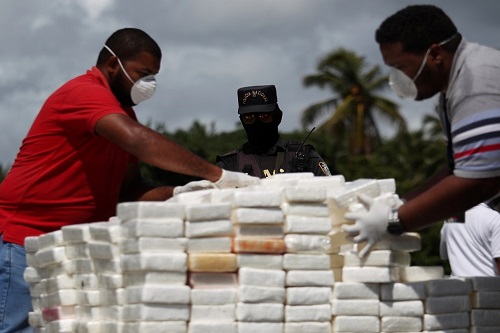Reuters photo
By
Ricardo Swire
Cocaine is the powerful stimulant narcotic that originates from South America’s cocoa plant. The processed product is cocaine hydrochloride or C17H21N04. Dried coca leaves alone only contain one percent of narcotic component, therefore transnational drug syndicates’ chemists incorporate alkaline substances such as water with a dissolved mineral usually lime. A cocktail of chemicals is added to cocaine hydrochloride to cause the transformation to solid residue.
Ultra-modern drug dealers degrade pure cocaine with fentanyl or the adulterant lidocine to maximise profitability. Other fillers such as lactose are added. To satisfy all cocaine user requirements the hydrochloride is removed, with baking soda or ammonia and water, to deliver a cheaper version called Crack. CARICOM internal security intelligence officials ponder fresh evidence that frames Ecuador’s port city Guayaquil as a major Colombian cartel cocaine trafficking conduit.
In April 2018 Ecuador’s Port Control Units (PCU), a combined police and customs enforcement team, seized two shipping containers collectively carrying more than one ton of cocaine. Overall trafficking trends showcased why Ecuador’s popular north-western route, via the coastal city of Esmeraldas, was demoted to second choice. The directional manoeuvre executed as an attempt to counter effective militarization along Ecuador’s border with Colombia.
The Ecuador/Colombia security operation deployed two thousand soldiers to Nariño department of Colombia. Ecuador’s National Anti-Narcotics Agency (NANA) data indicated street gangs are contracted by Colombian traffickers to provide transportation for transiting drug consignments. A recent vibrant Ecuadorean military presence in Esmeraldas has greatly influenced traffickers to redirect product movement. Alternative routes thru Santo Domingo, Chimborazo and Napo, bypass Esmeralda city.
The combined enforcement team increased presence and control of highways connecting Carchi, Sucumbios and Esmeraldas’ border provinces. Such areas are known to be controlled by crime lord “El Guacho” or The Horseman.” The cartel boss is suspected to be mastermind of the March 26, 2018 kidnapping of three El Comercio journalists. Previously a six hundred acre coca plantation, found in Ecuador’s north-east province, verified Colombian coca growers had geographically shifted cultivation.
An evasive move to sidestep ongoing aerial crop eradication programs, conducted by Colombian and US civilian defense contractors. Ecuador’s historic military discovery of two local cocaine labs, plus a covert factory in the Sucumbios district, shone light on the reality that Revolutionary Armed Forces of Colombia (FARC) operatives manufacture both cocaine and uniforms in Ecuador. On the night of June 27, 2018 Colombia Federal Police Counter-Narcotics agents intercepted two hundred and forty cases of calcium chloride, a cocaine related chemical, on a truck travelling between Babahoyo and Guayaquil.
Three Colombian male traffickers were detained. National intelligence reports connected El Guacho to the US$63,000 shipment. He provided resources and routes between Ecuador and Colombia. The suspect truck was monitored from its departure at Chontal town in Santiago, Ecuador. Law enforcement team also seized high-tech communications gear comprised of one satellite phone, three GPS devices and thirty-five radio scanners.
Ricardo Swire
Ricardo Swire is the Principal Consultant at R-L-H Security Consultants & Business Support Services and writes on a number of important issues.



No Comments Yet!
You can be first to comment this post!